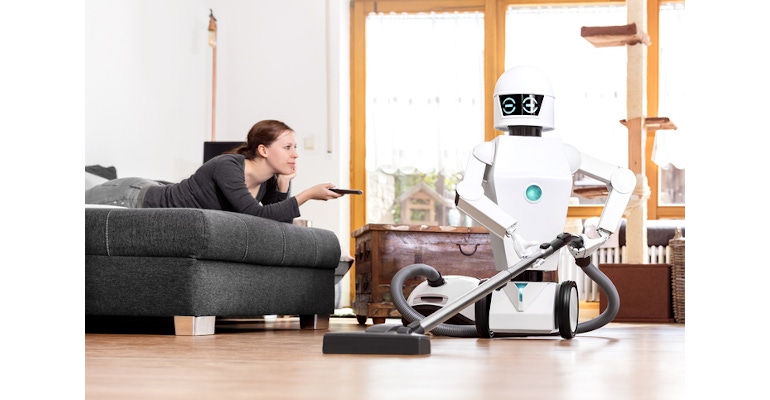Robots for the home and for the road must satisfy human needs. But why is the home a tougher road for robots?

We spend a lot of time performing mundane tasks like cleaning, organizing clothes or books, or prepping for cooking. We’ve had glimpses of home robots that can handle these tasks, but they’ve remained an unrealized dream for decades. Robotic assistants such as Rosie the Robot butler from The Jetsons and C-3PO and R2-D2 from Star Wars have been part of our culture for decades. According to a recent survey, just 36% of homes use “special-purpose robots” that handle tasks like vacuuming, pool cleaning, and lawn mowing. While multiple studies show that people like the idea of machines taking care of the tasks they consider the “four Ds” (dull, dirty, dangerous, and dear), the robotics industry is struggling to produce more general-purpose robots that are trainable and carry out multiple tasks.
Like home robots, self-driving cars have undergone a parallel evolution over the past decade, with high expectations for autonomy only partially realized. As it stands, even limited-geography for-hire robo-taxis require a remote human supervisor to deal with novel situations that may arise. Ultimately, though, self-driving cars have come further than home robots, as surprising as that may appear. The differences between home robots and self-driving cars can be analyzed from multiple perspectives, including manipulation, navigation, hardware, economics, and business models. In looking at them separately, we can understand the fundamental factors—and outstanding challenges—influencing the emergence and growth of home robots.
How Home Robots and Self-Driving Cars Are Comparable
General-purpose home robots and self-driving cars are both machines that integrate a sense-plan-control loop and are autonomous agents in human environments. Both require advanced machine-learning algorithms and decision-making systems to respond to complex, unpredictable situations in real time. Rodney Brooks, the roboticist who co-created the Roomba, predicts that a fully autonomous urban robo-taxi in a limited geographical area is not expected until 2032, and standalone dexterous robot hands are not expected until 2030. He doesn’t believe an affordable home robot that can navigate in a common U.S. home with all the complexities like clutter and narrow passageways will come about until 2035. A general-purpose home robot would combine dexterous robot hands with an affordable home robot that can navigate clutter and will take at least as long, most experts think. Even though these are guesstimates based on current trends, it raises the question of why home robots are more challenging to build than self-driving cars.
Challenges of Home Robots
Home robots operate in much more unstructured environments than do self-driving cars. Even the most ubiquitous home robot—robot vacuums—has to navigate surprisingly complex environments. They operate in places with dynamic obstacles, including children and pets, which do not obey traffic laws or have any constraints that city roads impose. They also encounter more objects than a self-driving car. In addition, navigating around narrow human environments requires understanding high-activity periods during the day as well as social cues.
A Promising Technology with Caveats
Self-driving cars reduce accidents, lessen fatigue, and provide a sense of independence to disabled people. In the extrapolated case of Level 5 full autonomy, one of the many advantages of self-driving cars—and more specifically, robo-taxis—is that they eliminate the need for a large number of parking lots for cars that are idle most of the day, and they reduce congestion in cities. While autonomous cars offer many advantages, they have been plagued by issues of safety and reliability. There have been cases of autonomous cars getting into accidents with parked emergency vehicles and entering construction zones—two situations that humans can clearly understand. Similar to the home robots, human environments can be quite dynamic and require ways of dealing with unknown objects more effectively.
The long tail for a self-driving car continues to evolve and must take into consideration conditions including extreme weather, blinding light, unpredictable pedestrian behavior, and many more. Despite this, a Level 4 (nearly fully autonomous) self-driving car is fully operable provided it offers a hand-off to a human driver in emergency situations.
Trends in Home Robots
Many trends are converging to reignite home robot development. One example is better computer architecture, which enables low-power computation, enabling cameras to perform object detection as well as human pose and face detection. Custom processors and vision processing units provide tera ops of processing on a single chip. The OAK-D camera backed by OpenCV (the open-source computer vision library) is a good example of a camera with configurable low-power computing. Hardware platforms such as Qualcomm’s Robotics RB5, Nvidia Xavier, and other low-cost system-on-chip solutions have enabled both powerful SLAM algorithms and deep-learning networks to work on the same integrated system.
Vision and camera technology have made rapid strides in the last decade, allowing robots to detect objects with just a few examples in training sets. The next frontier for home robots is the ability for someone to teach a robot butler new tasks or building enough intrinsic knowledge into the robots to perform useful tasks such as cleaning a countertop or picking up toys. Pretraining from self-supervised models such as CLIP (Contrastive Language-Image Pre-Training) is able to capture a significant amount of variety in the foundation model. Taking advantage of these trends, a fairly small team can ship a special-purpose home robot by using open-source tools to build all the fundamental algorithm blocks.
Cobots—collaborative robots that can work safely alongside humans and are primarily used in factories and warehouses—serve as a stepping stone between commercial and residential robots. Cobots offer a “smart stop” operation, which works via joint sensing-based force limitation and causes the robot to stop if they contact a human. Another category of cobots is called “inherently safe robots.” They are smaller than other home robots and incapable of injuring a human due to their low payloads (typically 1 kg maximum). These cobots work well for simple house chores such as cleaning surfaces.
Manipulation Is Tough
An additional challenge emerges when we move from home robots to robots with manipulators, and Moravec’s paradox as it applies to the complexity of sensorimotor skills that toddlers possess rings true. Picking up and moving objects is one of the fundamental—and most complicated—actions for a home robot, which requires dexterity and fine-motor control. It requires a combination of vision, touch, and proprioception. In order to see objects and manipulate them, the robot needs to track their location and shape while the robot itself is in motion. In addition, objects such as doors or drawers move in a specific way, which requires training or modeling. Once they’re within reach of the object, the touch sensing helps in verifying the size of the object and not damaging the object while handling it. The final aspect is proprioception, in which the robot has to be aware of the robot’s own body and movement to avoid collisions with its body while manipulating objects.
In comparison, a self-driving car has to move in accordance with the traffic rules without disrupting traffic and avoid collisions—overall a less complicated task.

Economics of Home Robots
Consumer vacuum robots have traditionally been price-sensitive. Higher-end home robots continue to have lower adoption. In the case of general-purpose robots, makers need to reshape consumer behavior through education and marketing more than adding raw technology. For a consumer to spend $1,000, they have to believe in the value in gained time and substantially reduced effort. Considering the cost of materials for such a robot as well as costs for sensors like cameras, lidars, force-feedback sensors, batteries, the controllers, and the processors, the total cost currently exceeds the price most consumers think is acceptable for a home appliance. The economies of scale would need to kick in before the price would become reasonable.
Customer expectations also need to match the actual capabilities of the device. As with any household appliance, when the expectation is high and the robot disappoints, it will impede adoption. Given their more-limited sensing and computation power, sometimes a robot is not able to relocalize itself and fails to go back to the dock automatically or it may not be able to adapt to all types of carpet. When home robots take too long to do their jobs, or cannot do them at all, consumers become disenchanted and stop using them.
Conversely, Level 4 self-driving cars are already in advanced testing in Phoenix and San Francisco. While there’s been a cooling in the lofty claims of autonomous vehicles, the features for Level 3 (semi-autonomous) are already in some cars and Level 4 is most likely to be reached within five years with a remote backup driver in position on urban taxis. General-purpose home robots, on the other hand, are not yet in this stage of development because they haven't been deployed sufficiently in enough people's homes. That feedback loop in interaction with humans hasn't even started yet for home robots.
The challenge with drastically new environments or weather remains for self-driving cars. However, the combination of recent advances in pre-training, collection of detailed maps, and a remote backup driver are making self-driving cars a reality more quickly than home robots.
Home Robots as Consumer Products
A mass consumer robot needs battery life, ruggedness, and environmental awareness. It needs to be affordable, safe around children and pets, and reliable, and it needs to offer clear benefits to consumers.
Usability and intuitiveness are critical factors because robots can be full of complicated features that need to feel natural to use for a mass consumer product. Consider the challenge of telling a general-purpose robot that a room should not be cleaned or that a table should be cleaned. Should this action happen via voice command delivered through a smart speaker, through visual demonstration captured by camera, or through a phone app? Another similar issue is how to train the arm of a home robot to make precise cuts when preparing vegetables. There’s a long list of demanding requirements that must be met for home robots to be truly effective in a mass consumer market.
Japanese companies have been building elder care robots for at least a decade, with limited success. They’re currently so expensive that they’re best used at large scale at a care facility. The downside of elder care robots is that they can eliminate staff-patient interaction, but given the dearth of care workers in most developed countries, more and more care facilities are likely to adopt elder care robots.
In the initial phase of introduction into people’s homes, Robot-as-a-Service (RaaS) is a business model worth exploring. RaaS, and more generally Hardware-as-a-Service (HaaS), is a way to avoid the high upfront cost of purchase of hardware and take care of deployment and customer support. Makers are responsible for performing upgrades, and there’s a lower barrier for customers to try out robots. Companies such as Grover are already successfully doing HaaS with electronic gadgets; home robots are a natural extension. With a more-predictable monthly revenue and longer customer relationships, RaaS could be beneficial to the robot maker as well.
Conclusion
Broadly, home robots need to improve in multiple and complex aspects, including navigation in messy environments, sensor costs, robotic manipulation, customer education, and human-robot communication. Conversely, the biggest challenges that remain with self-driving cars are production issues: training for rare and adverse cases, scaling to multiple cities with minimal software changes, and making self-driving cars affordable. Once home robots have been given the level of respect and recognition they deserve, and potential users realize they can perform tasks that make a huge difference in the quality of life for people—particularly the elderly—more funding will be available for home robots, and we’ll likely see a major surge in their development, improvements, and uptake. In the short term, you should expect to see more self-driving cars on the streets than home robots handling everyday chores.
About the Author(s)
You May Also Like





